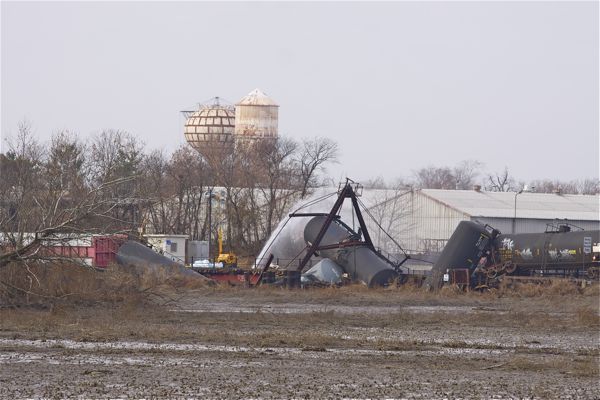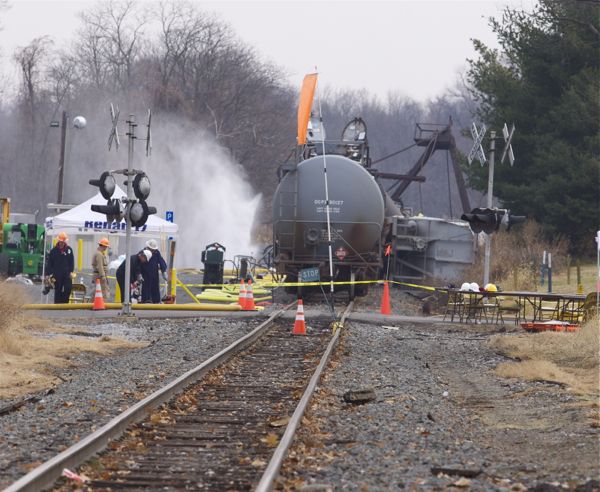Christie Silence in Wake of Paulsboro Toxic Train Disaster Contrasts With Obama’s Executive Order in Response to Texas Fertilizer Explosion
NJ Has Severe Risks Due to Dense Populations Nearby Chemical & Rail
Earlier this week, I contrasted NJ Gov. Christie’s response to the Paulsboror Toxic train derailment with Louisiana Gov. Jindal’s (see this).
But the better contrast is not with Jindal, it’s with President Obama.
Christie’s silence, neglect, failure to act – and the gross mismanagement by his DEP, including false statements that downplayed public health risks – is no accident.
It is a matter of policy, and direct result of the Governor’s “regulatory relief” policy under Executive Order #2.
That Order calls for “immediate regulatory relief”, which includes rolling back NJ’s strict state standards to their federal minimum counterparts. Across the board, DEP is on a short leash and any new DEP regulations are strictly verboten – just not to be even discussed.
(curious, the NJ press corps has reported the Christie slogan “red tape” HUNDREDS of times, but never – not once – used the actual Christie EO term to describe the policy, which is “regulatory relief”. Just another example of media bias and parroting of slogans).
The powerful chemical industry exercises an effective veto over the Christie Administration – and the NJ Legislature too.
So no wonder Christie was AWOL and DEP was downplaying risks and doing nothing to even suggest the need for new regulations.
But the NJ situation under Gov. Christie is very different than President Obama, who took action in the wake of the deadly April explosion at a Texas fertilizer plant.
The massive explosion at the plant in the community of West, Texas, killed 15 people, leveled hundreds of structures and damaged three of the town’s four schools. It also prompted new scrutiny of regulations at chemical plants and the risks posed by deadly chemicals to people living in surrounding areas.
In contrast to Gov. Christie, who has done nothing in response to the Paulsboro tragedy, on August 1, President Obama issued and executive Order to improve the regulation of and reduce risk from chemicals.
(for Beltway Inside EPA coverage of the Order, see : Obama Order May Boost Bid For Stricter EPA Fertilizer, Plant Safety Rules
(for the expected Republican attack on regulation and the chemical industry’s attempt to avoid EPA regulation in favor of laxer oversight under Homeland Security, see this story).
Here is the Obama Order:
Executive Order — Improving Chemical Facility Safety and Security
Section 6 of that Order is key – it provides:
c) Within 90 days of the date of this order, the Administrator of EPA and the Secretary of Labor shall review the chemical hazards covered by the Risk Management Program (RMP) and the Process Safety Management Standard (PSM) and determine if the RMP or PSM can and should be expanded to address additional regulated substances and types of hazards. In addition, the EPA and the Department of Labor shall develop a plan, including a timeline and resource requirements, to expand, implement, and enforce the RMP and PSM in a manner that addresses the additional regulated substances and types of hazards.
While it is targeted at risks from ammonium nitrate fertilizers in response to the Texas explosion, it could have a dramatic impact in NJ.
Let me suggest a few reasons why the Order has been ignored this far in NJ, and how it could have an impact:
1. The Order calls for improved coordination among federal, state, and local regulators on chemical safety and emergency response –
that is clearly in response not only to Texas, but the Paulsboro train derailment.
2. The Order calls for EPA to consider an expansion in types of risks regulated.
This too is clearly in response to paulsboro, where huge gaps in regulation were found in transportation, railroad, and local emergency plants and industry risk management plans.
EPA may consider risks from rail transportation and storage, HUGE issues here in NJ.
3. The Order calls for consideration of whether additional chemicals should be regulated.
NJ is a major chemical producing state – NJ has unique risks due to dense populations living very close chemicals plants ands railroads – the “kill zone”.
4. The Order includes identification of needed legislative initiatives.
5. The Order creates a process to consider additional requirements – best practices could include “inherently safer technologies” and “toxics use reduction”
Sec. 7. Identification of Best Practices. The Working Group shall convene stakeholders, including chemical producers, chemical storage companies, agricultural supply companies, State and local regulators, chemical critical infrastructure owners and operators, first responders, labor organizations representing affected workers, environmental and community groups, and consensus standards organizations, in order to identify and share successes to date and best practices to reduce safety risks and security risks in the production and storage of potentially harmful chemicals, including through the use of safer alternatives, adoption of best practices, and potential public-private partnerships.
Now the question becomes, will this Order even get media and environmental group attention in NJ?
A similarly important Obama Executive Order on Sandy got zero converge and no engagement by NJ “environmentalists” see:
How can this be happening again?



Pingback: ebook stores
Pingback: ebook website
Pingback: fitflop Chaussures
Pingback: Roger Vivier shoes
Pingback: fastest wow gold
Pingback: ray ban solbriller
Pingback: arsenal home gk kit
Pingback: camiseta nueva del barcelona
Pingback: maillot bayern munich flocage
Pingback: camiseta de colombia blanca manga larga
Pingback: camisetas del real madrid para bebes
Pingback: camiseta alterna brasil 2013
Pingback: camisetas frikis madrid
Pingback: t shirt barcelona nike
Pingback: que numero de camiseta tiene messi en argentina
Pingback: maillot barcelone xxl
Pingback: camiseta seleccion colombia blanca para mujer
Pingback: maillot de basket france personnalise
Pingback: camisetas baratas futbol club barcelona
Pingback: camiseta ni?o real madrid 2012 barata
Pingback: maillot cycliste national belge
Pingback: maillot argentine fut 14
Pingback: trikot fc bayern 2012 13
Pingback: comprar camisa da universidad do chile
Pingback: psg handball trikots
Pingback: comprar camiseta seleccion uruguay
Pingback: where can i buy a manchester city shirt
Pingback: wie sieht das neue schalke trikot aus
Pingback: england national team jersey nike
Pingback: la nueva camiseta de la seleccion colombia
Pingback: achetez maillot psg domicile 2013
Pingback: real madrid champions league shirt 11 12
Pingback: camiseta de uruguay femenina
Pingback: camisetas de f锟斤拷tbol chileno
Pingback: schalke trikots selbst gestalten
Pingback: camisa brasil do flamengo
Pingback: camiseta seleccion argentina pes 2012
Pingback: as roma replica shirts
Pingback: precio camiseta dela seleccion colombia
Pingback: bayer leverkusen trikot bestellen
Pingback: fotos de camisetas del barca
Pingback: ultima camiseta del madrid
Pingback: belgium football kit world cup 2014
Pingback: buy tottenham shirt 2013 14